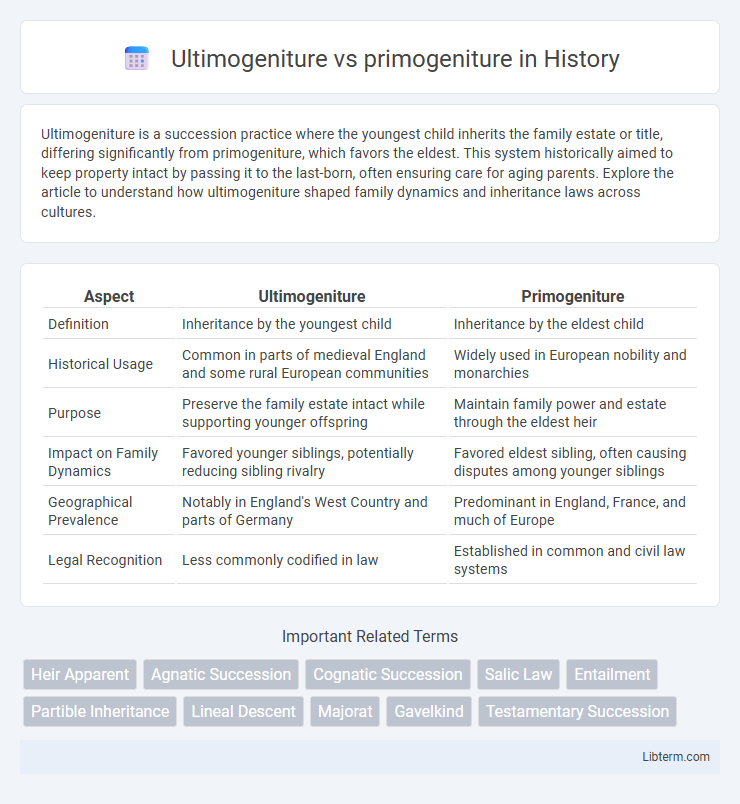Ultimogeniture is a succession practice where the youngest child inherits the family estate or title, differing significantly from primogeniture, which favors the eldest. This system historically aimed to keep property intact by passing it to the last-born, often ensuring care for aging parents. Explore the article to understand how ultimogeniture shaped family dynamics and inheritance laws across cultures.
Table of Comparison
| Aspect | Ultimogeniture | Primogeniture |
|---|---|---|
| Definition | Inheritance by the youngest child | Inheritance by the eldest child |
| Historical Usage | Common in parts of medieval England and some rural European communities | Widely used in European nobility and monarchies |
| Purpose | Preserve the family estate intact while supporting younger offspring | Maintain family power and estate through the eldest heir |
| Impact on Family Dynamics | Favored younger siblings, potentially reducing sibling rivalry | Favored eldest sibling, often causing disputes among younger siblings |
| Geographical Prevalence | Notably in England's West Country and parts of Germany | Predominant in England, France, and much of Europe |
| Legal Recognition | Less commonly codified in law | Established in common and civil law systems |
Introduction to Inheritance Systems
Ultimogeniture and primogeniture are two distinct inheritance systems determining the succession order within families. Primogeniture grants inheritance rights to the firstborn child, typically favoring the eldest son, ensuring estate continuity through senior lineage. Ultimogeniture, in contrast, allocates inheritance to the youngest child, often emphasizing care for aging parents and shifting familial resource distribution to the junior lineage.
Defining Ultimogeniture
Ultimogeniture is a hereditary succession system where the youngest child inherits the family estate, contrasting with primogeniture, which favors the eldest. This practice, also known as "junior right," often ensured the care of aging parents by the last-born offspring. Historically, ultimogeniture was common in certain English and Asian communities, highlighting diverse cultural approaches to inheritance and familial responsibility.
Understanding Primogeniture
Primogeniture is the inheritance system where the eldest child, typically the firstborn son, receives the entire estate, ensuring the property remains intact and consolidated across generations. This method promotes family wealth preservation and social stability by preventing the division of land or titles among multiple heirs. In contrast, ultimogeniture favors the youngest child, but primogeniture remains the dominant legal tradition in many cultures and historical contexts.
Historical Origins of Succession Practices
Ultimogeniture and primogeniture are two distinct inheritance systems that emerged from different historical and cultural contexts. Primogeniture, prevalent in medieval Europe, prioritized the eldest son to maintain estate integrity and prevent fragmentation of noble lands. Ultimogeniture, found in certain rural societies like parts of England and Asia, favored the youngest son, reflecting agrarian needs where the youngest child often remained at home to care for aging parents and inherit the family property.
Geographic Distribution of Ultimogeniture and Primogeniture
Ultimogeniture, the practice where the youngest child inherits the estate, is predominantly found in parts of England, Germany, and some South Asian communities, reflecting localized customary laws. Primogeniture, favoring the eldest child's inheritance, is widespread across Western Europe, particularly in England, France, and Spain, and shaped aristocratic and monarchical successions. The geographic distribution of these inheritance systems correlates with cultural, legal, and historical factors influencing property transmission and family structure in respective regions.
Social Implications of Inheritance Laws
Ultimogeniture and primogeniture shape family dynamics and socioeconomic structures by determining inheritance distribution, where primogeniture favors the eldest child, often reinforcing wealth concentration and social hierarchy. Ultimogeniture, granting assets to the youngest child, can alter traditional family roles and impact land tenure systems, potentially reducing elder siblings' economic status. These inheritance laws influence social mobility, power distribution, and regional land fragmentation, deeply affecting community stability and class stratification.
Economic Impact on Families and Estates
Ultimogeniture often results in smaller, less economically powerful estates as younger children inherit property, potentially fragmenting assets and reducing overall wealth concentration. Primogeniture typically ensures estate consolidation under the eldest child, preserving larger landholdings and promoting economic stability within families over generations. The economic impact of primogeniture favors long-term investment and estate viability, while ultimogeniture may encourage diversification but risks financial dilution.
Gender Roles in Succession Systems
Ultimogeniture and primogeniture shape gender roles in succession by dictating inheritance rights based on birth order, often privileging male heirs in patriarchal societies. In primogeniture, the eldest son typically inherits titles and property, reinforcing male dominance in lineage and power transfer, while ultimogeniture favors the youngest son, potentially altering family dynamics but still often excluding daughters. These systems reflect and perpetuate gender-based hierarchies, influencing social structures and the distribution of wealth and authority across generations.
Transition and Decline of Traditional Inheritance Patterns
The transition from primogeniture to ultimogeniture marked a significant shift in inheritance customs, often influenced by changing economic structures and social norms. Primogeniture, favoring the eldest son, began to decline as egalitarian principles and legal reforms promoted more balanced asset distribution among all offspring. This decline facilitated the emergence of ultimogeniture in certain regions, where the youngest child inherited, reflecting evolving family dynamics and property management strategies.
Modern Relevance and Legal Perspectives
Ultimogeniture, where the youngest child inherits the estate, contrasts with primogeniture, favoring the eldest child, both systems now face challenges in modern legal frameworks emphasizing equality. Contemporary inheritance laws in many countries reject these traditional norms to promote equitable distribution among all heirs, reflecting shifts toward gender-neutral and age-agnostic succession. Legal debates continue regarding the cultural preservation of these customs versus adherence to statutory reforms that align with current human rights standards.
Ultimogeniture Infographic

 libterm.com
libterm.com